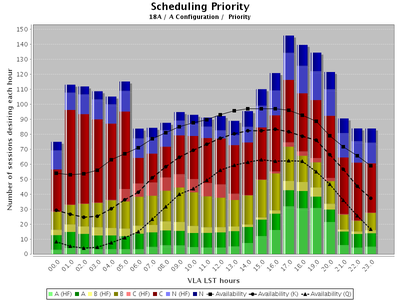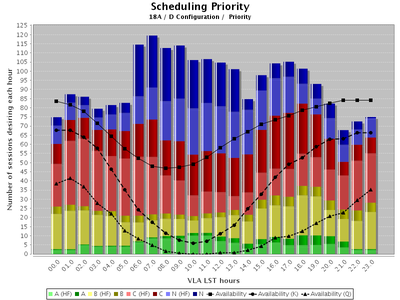18A TAC Report
Summary
A total of 259 proposals were submitted to NRAO's Karl G. Jansky Very Large Array (VLA) in semester 18A. Proposals are reviewed on a competitive basis with a panel review system (see Proposal Review System). Below are the statistics by proposal count and hours. The oversubscription is the ratio of the number of submitted proposals to the number of approved proposals. The pressure is the ratio of the requested time to the available time in hours. Here we only include proposals submitted for the 18A semester that have been reviewed by the NRAO TAC. We count HSA proposal hours that request the VLA as a VLBI station.
|
|
For the 18A semester, the NRAO had agreements with the Hubble Space Telescope (HST), the Swift Gamma-Ray Burst Mission, and the Chandra X-ray Observatory to submit joint proposals whereby the NRAO TAC could allocate time on these external facilities (see the 18A Call for Proposals). The table below summarizes the results for 18A for the VLA. The time available on the external facilities is per year and includes the GBT and VLBA.
|
HST (Orbits) | Swift (ks) | Chandra (ks) | |
|---|---|---|---|
|
Available |
30 | 300 | 120 |
| Requested | 42 | 298 | 266.2 |
| Approved | 18 | 93 | 86.2 |
Telescope Pressure Plots
Pressure plots show the total hours of allocated time as a function of LST. Also shown are how the hours are divided with respect to weather conditions and observing priority. Click on the plot to enlarge. The VLA has two weather categories: high frequency (above 12 GHz, light shading) and low frequency (below 12 GHz, dark shading). The figure below shows the pressure for the A and B configurations. The black lines indicate the total time available for science (solid), the time available for K-band and higher frequencies (dashed), and the time available for Q-band (dotted). The letters A, B, C, and N correspond to the priorities assigned by the TAC where A and B are approved time, C is filler time, and N is rejected time.
Observation Preparation
In semester 18A, daytime maintenance activities peak at about 02 hours LST and 10 hours LST for the A and D configurations, respectively, so observing pressure is highest there. Proposals approved for priority A, B or C time become ineligible when the associated configuration ends, unless explicitly stated otherwise in the Comments from the TAC. Those allocated dynamic time should begin their scheduling block preparation about two weeks before the planned start of the configuration (see Configuration Plans).
Any approved time may be divided into multiple scheduling blocks as appropriate, considering the scheduling priority, observing frequency, LST range suitable for the target(s), and LST pressure. For advice, please consult the VLA Observing Guide.
Unless stated otherwise, any time allocated is only for the identified proposal, and no modification in the project should be made without obtaining permission from NRAO scheduling staff. To seek permission, submit a ticket to the Proposal Review department of the NRAO Helpdesk.






Connect with NRAO